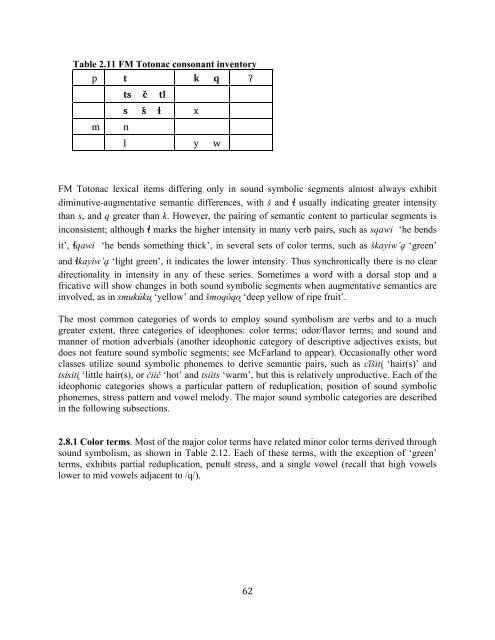The phonology and morphology of Filomeno Mata Totonac
The phonology and morphology of Filomeno Mata Totonac
The phonology and morphology of Filomeno Mata Totonac
You also want an ePaper? Increase the reach of your titles
YUMPU automatically turns print PDFs into web optimized ePapers that Google loves.
Table 2.11 FM <strong>Totonac</strong> consonant inventory<br />
p t k q !<br />
m n<br />
ts c! tl<br />
s s! " x<br />
l y w<br />
FM <strong>Totonac</strong> lexical items differing only in sound symbolic segments almost always exhibit<br />
diminutive-augmentative semantic differences, with # <strong>and</strong> " usually indicating greater intensity<br />
than s, <strong>and</strong> q greater than k. However, the pairing <strong>of</strong> semantic content to particular segments is<br />
inconsistent; although " marks the higher intensity in many verb pairs, such as sqawi ‘he bends<br />
it’, "qawi ‘he bends something thick’, in several sets <strong>of</strong> color terms, such as #kayiw’! ‘green’<br />
<strong>and</strong> "kayiw’! ‘light green’, it indicates the lower intensity. Thus synchronically there is no clear<br />
directionality in intensity in any <strong>of</strong> these series. Sometimes a word with a dorsal stop <strong>and</strong> a<br />
fricative will show changes in both sound symbolic segments when augmentative semantics are<br />
involved, as in smukúku" ‘yellow’ <strong>and</strong> #moqóqo" ‘deep yellow <strong>of</strong> ripe fruit’.<br />
<strong>The</strong> most common categories <strong>of</strong> words to employ sound symbolism are verbs <strong>and</strong> to a much<br />
greater extent, three categories <strong>of</strong> ideophones: color terms; odor/flavor terms; <strong>and</strong> sound <strong>and</strong><br />
manner <strong>of</strong> motion adverbials (another ideophonic category <strong>of</strong> descriptive adjectives exists, but<br />
does not feature sound symbolic segments; see McFarl<strong>and</strong> to appear). Occasionally other word<br />
classes utilize sound symbolic phonemes to derive semantic pairs, such as c'í#iti" ‘hair(s)’ <strong>and</strong><br />
tsísiti" ‘little hair(s), or $ii$ ‘hot’ <strong>and</strong> tsiits ‘warm’, but this is relatively unproductive. Each <strong>of</strong> the<br />
ideophonic categories shows a particular pattern <strong>of</strong> reduplication, position <strong>of</strong> sound symbolic<br />
phonemes, stress pattern <strong>and</strong> vowel melody. <strong>The</strong> major sound symbolic categories are described<br />
in the following subsections.<br />
2.8.1 Color terms. Most <strong>of</strong> the major color terms have related minor color terms derived through<br />
sound symbolism, as shown in Table 2.12. Each <strong>of</strong> these terms, with the exception <strong>of</strong> ‘green’<br />
terms, exhibits partial reduplication, penult stress, <strong>and</strong> a single vowel (recall that high vowels<br />
lower to mid vowels adjacent to /q/).<br />
! *#!

















